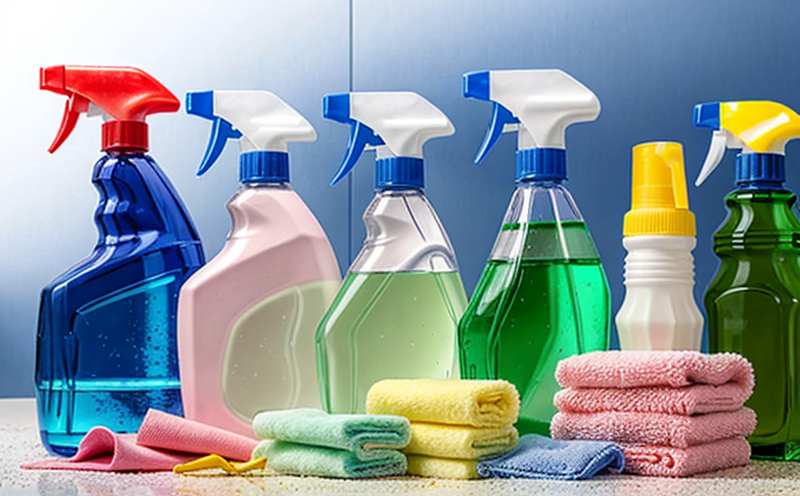Flammability Testing of Cleaning Sprays
The flammability testing of cleaning sprays is a critical component in ensuring product safety and compliance with various regulatory standards. Flammability tests are essential to determine the likelihood that a product will ignite or burn under specific conditions, which can be particularly important for volatile materials such as cleaning sprays.
Cleaning spray products are often used in environments where they could come into contact with ignition sources or flammable substances. Understanding and managing their flammability characteristics is crucial to prevent fires, explosions, and potential injuries. This testing involves several stages, including sample preparation, instrumentation selection, test procedures, and data analysis.
Flammability tests for cleaning sprays typically follow internationally recognized standards such as ASTM E681-20 or ISO 13949:2017. These standards provide detailed protocols to ensure consistent and accurate testing results. The first step in the process is to prepare the sample by ensuring it represents the product as it would be used. This involves selecting a representative sample that mimics real-world conditions, such as temperature and pressure.
Once prepared, the cleaning spray is subjected to various tests designed to assess its flammability characteristics. These tests may include but are not limited to the Closed Cup Flash Point Test (ASTM D56-18), which measures the lowest temperature at which a liquid can give off sufficient vapor to form an ignitable mixture with air near the surface of the liquid.
The apparatus used in these tests includes closed cup flash point testers, gas chromatographs, and other specialized equipment tailored to measure flammable properties. The results of these tests are then analyzed to determine the flash point, which is a key indicator of a product's flammability. A lower flash point indicates greater potential for flammability.
Beyond just assessing the immediate flammability risk, flammability testing also helps in understanding how cleaning sprays behave under different conditions. This information can be used to improve formulations and enhance safety features, such as the addition of flame retardants or other stabilizing agents. It is crucial for manufacturers and quality managers to ensure that their products meet regulatory requirements, which vary by jurisdiction.
For instance, in the United States, regulations like those found in NFPA 96 may apply, while European markets might follow EN standards such as EN 50287. Compliance with these standards not only protects end-users but also helps companies avoid potential legal and financial penalties associated with non-compliance.
Additionally, flammability testing plays a vital role in the development of new products within this category. R&D engineers can use test results to refine formulations and improve product performance while ensuring safety standards are met. This iterative process is essential for maintaining high-quality standards in consumer products and enhancing overall market trust.
- ASTM E681-20: Standard Test Method for Flash Point by Closed-Cup Tester
- ISO 13949:2017: Safety of machinery - Electrical equipment of machines in general
- NFPA 96: Standard for the Installation of Ventilation Systems in Commercial Cooking Operations
Benefits
The benefits of flammability testing extend beyond mere compliance with regulations. By conducting thorough tests, manufacturers can significantly enhance the safety and reliability of their cleaning spray products. This not only protects end-users but also strengthens brand reputation and customer trust.
One significant benefit is the reduction in risk of fires and explosions. Flammable materials are a leading cause of accidents, particularly in environments where they come into contact with ignition sources. By identifying and mitigating flammability risks early in the product lifecycle, manufacturers can prevent such incidents from occurring.
Another key advantage is enhanced regulatory compliance. With increasing global standards for safety and environmental protection, adherence to these regulations is not only a legal requirement but also a strategic business decision. Companies that fail to comply risk fines, product recalls, and damage to their reputation. Flammability testing ensures that products meet the necessary criteria set by relevant authorities.
Flammability testing also offers valuable insights into the behavior of cleaning sprays under various conditions. This knowledge can be used to optimize formulations, improve product performance, and enhance user experience. For example, understanding how a spray behaves at different temperatures or pressures can lead to better design decisions that ensure consistent quality.
Moreover, flammability testing contributes to environmental sustainability by helping manufacturers identify areas where they can reduce the risk of accidental fires while minimizing waste and resource consumption. This aligns with broader corporate sustainability goals and demonstrates a commitment to responsible business practices.
Environmental and Sustainability Contributions
By reducing the likelihood of accidental fires, flammability testing helps prevent environmental contamination from fires that could release harmful chemicals into air and water. This reduces the need for emergency clean-up operations.
Flammable products are often associated with higher production costs due to additional safety measures. By minimizing these risks through rigorous testing, manufacturers can reduce overall resource consumption throughout the product lifecycle.
Testing ensures that cleaning sprays are formulated in a way that minimizes volatile organic compound (VOC) emissions, contributing positively to air quality and reducing the environmental impact of product use.
Competitive Advantage and Market Impact
Flammability testing provides a competitive edge by ensuring that products meet or exceed regulatory requirements. This not only reduces the risk of compliance issues but also positions companies as leaders in product safety and quality.
In today’s market, where consumer trust plays a crucial role in brand perception, demonstrating a commitment to safety through rigorous flammability testing can significantly enhance brand reputation. Consumers are increasingly aware of the risks associated with flammable products, and those who take proactive steps to mitigate these risks are likely to gain favor.
From a market impact perspective, companies that invest in flammability testing are better positioned to expand into new markets where regulatory standards may be more stringent. This can open up opportunities for growth and innovation within the cleaning product industry. Additionally, by leading the way in safety and sustainability practices, these companies set a benchmark for others to follow, contributing to a safer and more responsible market environment.





